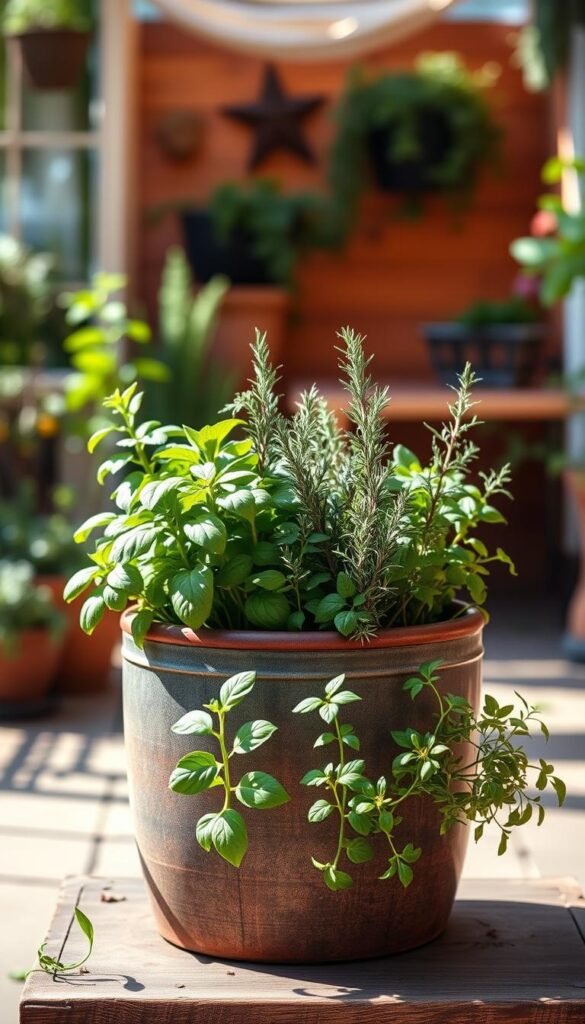Imagine stepping outside your door to snip fresh basil for pasta or mint for iced tea. Container gardening brings that dream within reach, even if you’re new to plants. With just a few pots and sunlight, you can create a vibrant herb garden that fits on a windowsill, balcony, or patio.
Why containers? They let you control soil quality and move plants as seasons change. No yard? No problem! Many herbs thrive in small spaces, making them perfect for small-space gardening. Plus, having fresh ingredients steps from your kitchen transforms everyday meals into something special.
You’ll love how pots add style to your space. Arrange them at different heights for visual interest, or mix colors for a cheerful display. Even better: growing your own cuts grocery trips and ensures pesticide-free flavors.
This guide covers everything from choosing the right containers to simple care routines. You’ll discover hardy varieties that forgive occasional missed waterings and learn to protect plants during frost. Let’s turn your cooking—and your outdoor areas—into sources of pride and joy.
Understanding the Basics of Container Herb Gardening
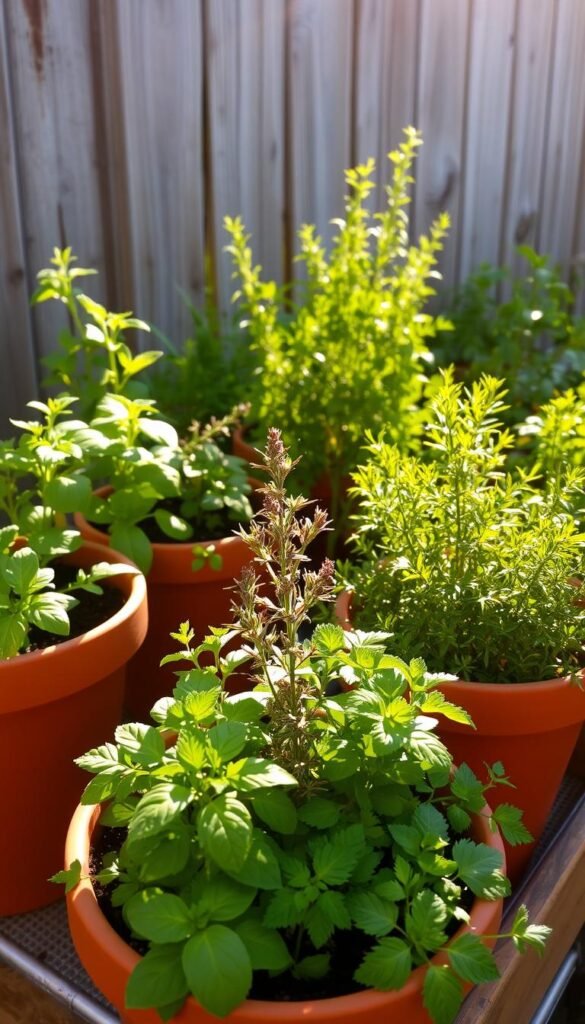
Transforming small spaces into lush gardens starts with smart container choices. Pots give you command over your plants’ environment, letting you tweak soil blends or shuffle greenery to chase sunlight. This flexibility makes container growing a favorite for busy folks craving fresh flavors without the fuss.
Why Pots Make Gardening Easier
Containers let you fix common issues fast. Swap soggy soil in minutes or move basil away from harsh afternoon full sun. You’ll water precisely—no wasted resources—and fertilize only what needs it. When frost threatens, just carry pots indoors overnight. Bonus: vigorous growers like mint won’t invade your other plants when confined to their own space.
Light and Temperature Secrets
Most herbs demand 6+ hours of daily light. Rosemary and thyme love blazing full sun, while parsley thrives in morning rays with afternoon shade (full sun partial). Proper conditions boost leaf oils, making flavors pop. Picture snipping citrusy lemon balm for tea after it soaks up summer warmth. Rotate pots weekly so all sides get equal sun exposure—your plants will reward you with bushier growth.
Container Selection and Soil Essentials
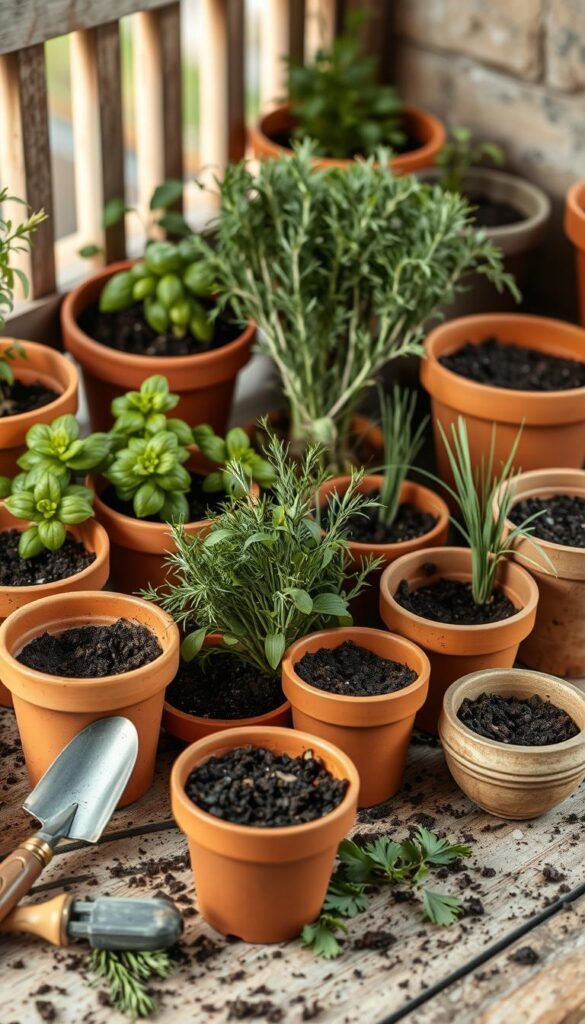
Your herb garden’s success starts with two simple choices: the right homes for your plants and the dirt they’ll call home. Smart container and soil decisions create thriving greenery, whether you’re growing sun-loving rosemary or shade-tolerant mint.
Choosing the Perfect Pots for Your Herbs
Size matters. Small herbs like thyme need 6-8″ deep pots, while basil prefers 12″ containers. Drainage holes are non-negotiable—they prevent soggy roots. Terra cotta breathes better than plastic but dries faster. Glazed ceramic strikes a balance for moist soil lovers like parsley.
| Material | Pros | Cons |
|---|---|---|
| Terra Cotta | Airflow, natural look | Dries quickly |
| Plastic | Lightweight, retains moisture | Poor drainage if unmodified |
| Fabric | Prevents root circling | Needs frequent watering |
Preparing and Amending Your Potting Mix
Bagged potting mix beats garden soil for containers. Boost it with perlite (30%) for drainage and compost (20%) for nutrients. For herbs needing partial shade, add water-retaining coconut coir. This blend keeps roots happy between waterings and helps avoid common container gardening mistakes like root rot.
Refresh soil every spring by replacing the top third with new mix. Your plants will reward you with lush growth—no yard required!
No-Fail Herbs to Grow in Containers for Beginners

Three standout plants elevate every dish while thriving in pots. Lemon thyme’s citrusy punch, nasturtium’s peppery blooms, and lemon balm’s calming aroma turn small spaces into sensory experiences. Each adapts beautifully to container life with smart care.
Herb Profiles: Bright Flavors, Easy Care
Lemon thyme thrives in 6+ hours of sun. Its zesty leaves intensify when watered only after soil dries. Trim stems weekly to encourage bushiness—perfect for marinades or compound butter.
Nasturtium’s edible flowers flourish in partial shade. Let soil dry slightly between waterings for bold peppery notes. Train vines over pot edges for cascading color.
Lemon balm grows vigorously in afternoon shade. Pinch flower buds to maintain leaf production. Rub a leaf between fingers for instant stress relief—nature’s aromatherapy!
Culinary Stars That Impress
‘Genovese’ basil demands full sun and moist soil. Harvest from the top down to delay flowering. Its clove-like sweetness transforms pesto and caprese salads.
Variegated pineapple mint adds striped beauty to drinks. Confine roots in 10″ pots to control spreading. The tropical aroma pairs magically with summer fruits.
‘Forest Green’ parsley offers dark, crinkled leaves rich in vitamins. Rotate pots daily for even growth. Snip outer stems first—this biennial keeps giving for months.
Caring for Your Container Herb Garden
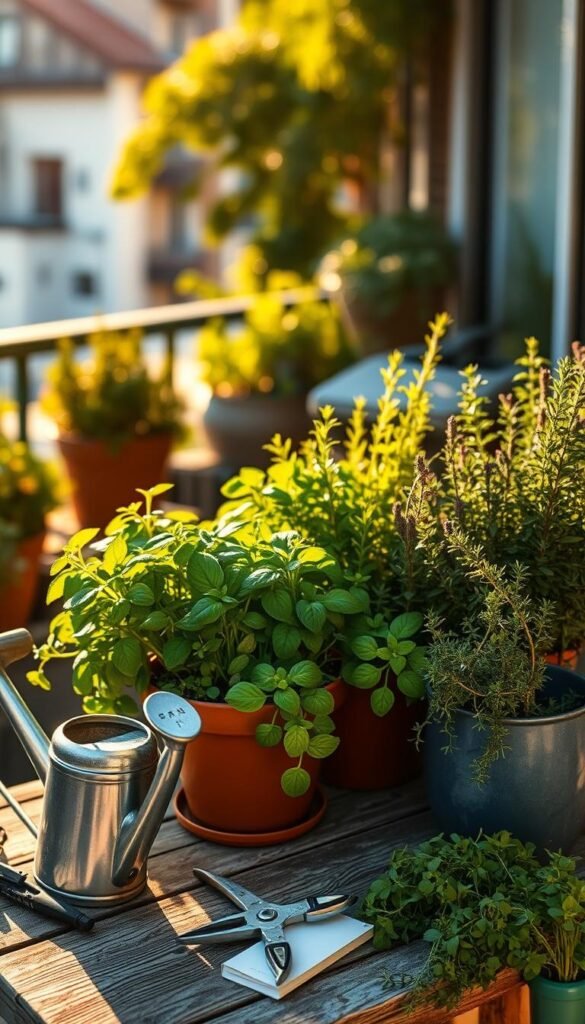
Nurturing your potted herbs transforms routine care into flavorful rewards. With consistent attention to three key areas—hydration, nutrition, and shaping—you’ll enjoy bushy plants bursting with fragrant leaves all season long.
Smart Watering Made Simple
Check soil moisture by sticking your finger one inch deep. Water when it feels dry, but skip if cool or damp. Basil and mint prefer consistently moist roots, while rosemary thrives with occasional dry spells.
| Sign | Overwatered | Underwatered |
|---|---|---|
| Leaves | Yellow, limp | Crispy edges |
| Soil | Moldy smell | Pulls from pot edges |
| Growth | Stunted | Slow |
Feeding and Shaping Strategies
Use liquid seaweed fertilizer every 14 days during active growth. Morning applications prevent sun-scorched leaves. For flowers like chamomile, switch to bloom-boosting formulas once buds form.
Snip stems just above leaf nodes using clean scissors. This trick encourages new growth from the base, keeping plants compact. Harvest outer leaves first on parsley and cilantro—they regenerate fastest.
Rotate pots weekly for even sun exposure. Your herbs will grow symmetrical instead of leaning toward light sources. Remember: gentle care creates healthier plants that withstand pests and weather changes better.
Designing and Arranging Your Herb Garden
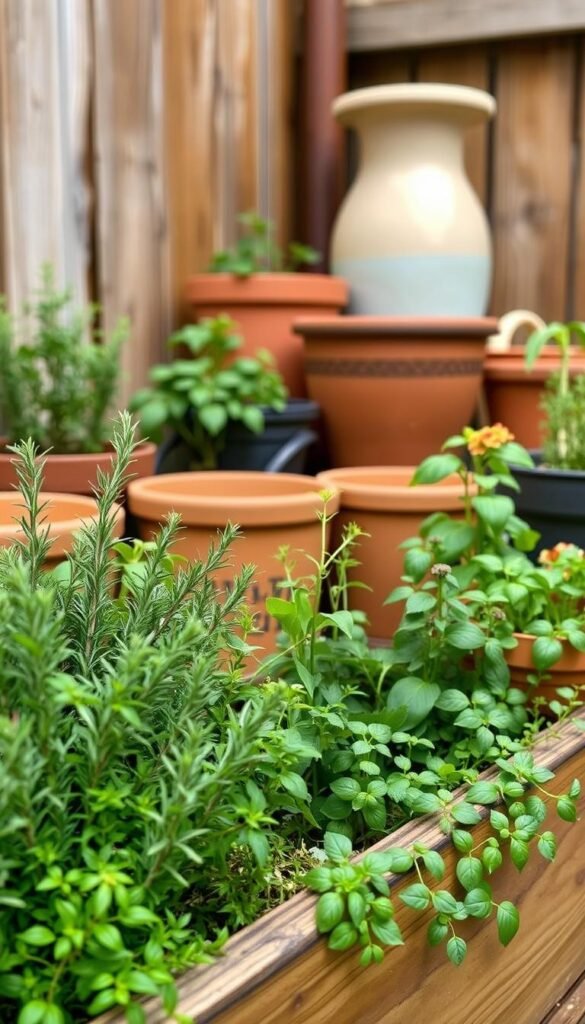
Turn your balcony into a living masterpiece with clever herb arrangements. Strategic layouts maximize both beauty and function, letting you enjoy fresh flavors while creating an inviting outdoor retreat. The right design choices help plants thrive through seasonal shifts and shifting light patterns.
Creative Container Layouts and Repotting Techniques
Mix pot heights for visual drama. Place tall rosemary in back, medium basil in the middle, and trailing thyme at the front. This tiered approach gives each plant space while creating depth. For small spaces, try vertical shelves or hanging planters.
Repot when roots peek through drainage holes. Gently loosen root balls and upgrade to pots 2″ wider. Spring is ideal for this refresh—your plants gain room to stretch while you replace tired soil. Rotate herbs between containers yearly to prevent nutrient depletion.
| Layout Strategy | Benefit | Best For |
|---|---|---|
| Vertical stacking | Saves floor space | Balcony rails |
| Color grouping | Enhances visual appeal | Modern patios |
| Seasonal rotation | Optimizes light exposure | Year-round growth |
Seasonal Adjustments and Light Management
Shift pots closer to south-facing windows in winter for maximum sun hours. Use rolling plant stands for easy repositioning. In summer, create sun partial shade with taller plants or sheer curtains to prevent leaf scorch.
Track daily light patterns using a patio sun calculator. Herbs needing 6+ hours of light thrive on west-facing surfaces, while shade-lovers prefer east-side morning rays. Rotate pots weekly so all sides receive equal exposure—your plants will grow fuller instead of leaning.
Choose glazed ceramic pots in earthy tones to complement green foliage. Cool blues make silver-leafed sage pop, while terracotta warms up parsley’s dark leaves. Remember: smart design solves practical needs while making your space magazine-worthy!
Wrapping Up Your Container Herb Journey
Every snip of homegrown herbs transforms meals into culinary masterpieces. You’ve learned how well-drained soil and smart pot choices create thriving plants, even in tight spaces. Remember: check roots annually, refresh potting mix, and rotate containers for balanced growth.
Keeping plants healthy boils down to consistency. Water when soil feels dry, trim regularly, and use organic fertilizers. Experiment with bold pairings—try lemon balm in teas or peppery nasturtium blooms in salads. These easy-grow varieties adapt to your routine while rewarding curiosity.
Start new adventures with seeds or cuttings. Basil sprouts quickly on sunny windowsills, while mint spreads joyfully from rooted stems. Your personalized herb collection reflects both taste and space—stack pots vertically or cluster colorful planters for visual flair.
As seasons change, so will your garden’s needs. Protect tender leaves from frost, and welcome spring with refreshed soil. With each harvest, you’ll savor flavors no store-bought jar can match. Let this living pantry inspire endless kitchen creativity!

